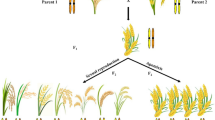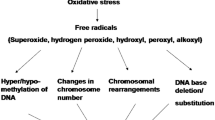Abstract
The morphology and cytology of selected hybrid swarms of wild and cultivated rices were studied following natural hybridization between the native species Oryza rufipogon Griff and exotic species Oryza sativa L. (var. Thaothabi and Moirangphoe). Similar studies were also conducted on populations developed through artificial hybridization of those two species. The morphological variation in plant height, anthocyanin pigmentation, Kernel and husk colour, sterility, presence of awns and grain shattering habits were similar in both natural (hybrid swarms) and artificially derived populations of interspecific hybrids. The cytological abnormalities such as quadrivalant formation at metaphase I, delayed separation, laggards and bridge formation, unequal separation and chromosomal elimination were also observed in both populations. These results indicated that the evolution of intermediate types had occurred due to genetic introgression from cultivated species to wild species. A systematic extinction of founder population was also noticed due to sudden ecological changes like deep submergence to medium submergence and human interference by growing cultivated species O. sativa L. in the area where wild species were being grown.
Similar content being viewed by others
References
Anderson, E. & G.L. Stebbins, 1954. Hybridization, as on evolutionary stimulus. Evolution 8: 378–388.
Anonymous, 1980. Standard evaluation system for rice. International rice testing program. Second edition.
Basak, S.L. & S. Dana, 1967. Structural differentiation in natural population of Oryza sativa species complex. Nucleus 10(1–2): 15.
Brown, M.S., M.Y. Menzel, C.A. Hasenkampf & S. Nagi, 1981. Chromosome configurations and orientations in 58 heterozygous translocations in Gossypium hirsutum. J. Hered 72: 161–168.
Chang, T.T. & C.C. Li, 1980. Genetics & Breeding in Rice: Production and Utilization. Ed. by B.S. LUH, pp. 87–146.
Gottschalk, W., 1978. Open problems in polyploid research. Nucleus 21: 91–112.
Govindaswami, S., A. Krishnamurthy & N.S. Sastry, 1966. The role of introgression in the varietal variability in rice in the Jeypore tract of Orissa. Oryza 3(1): 78–85.
Harlan, J.R., 1963. Two kinds of gene centres in Bothriochloinae. Amer Nat 97: 91–98.
Jennings, P.R. & R.C. Acquino, 1968. Studies on competition in rice. The mechanism of competition among phenotypes. Evolution 22: 529–542.
Kiang, Y.T., J. Antonovics & L. Wu, 1979. The extinction of wild rice (Oryza perennis formosana) in Taiwan. J Asian Ecol 1: 1–9.
Mitsugu Eiguchi & Yoshio Sano, 1990. A gene complex responsible for seed shattering and panicle spreading found in common wild rice. Rice Genet News Lett 7: 105–107.
Mori, K., T. Kinosita & M. Takahasi, 1973. Linkage relationship of genes for some mutant characters of rice kept in Kyushu University. Genetical studies on rice plant. LVJ Fac Ag Hokaido Univ 8: 377–385.
Morishima, H., H.I. Oka & W.T. Chang, 1961. Directions of differentiation in population of wild rice, Oryza perennis and Oryza sativa or spontanea. Evolution 15: 326–339.
Oka, H.I., 1964. Pattern of interspecific relationship and evolutionary dynamics in Oryza: Rice Genetics and Cytogenetics, I.R.R. 71–91. Elsevier Publ. Co., Amsterdam.
Oka, H.I. & W.T. Chang, 1959. The impact of evolution on population of wild rice, Oryza sativa L. Spontanea. Phyton 13: 105–117.
Oka, H.I. & W.T. Chang, 1961. Hybrid swarms between wild and cultivated rice species, Oryza perennis and Oryza sativa. Evolution 15: 418–430.
Richharia, R.H., S. Govindaswamy & A.K. Ghosh, 1966. Introgression between O. perennis and O. sativa. A case of variation in O. Sativa var. Spontanea (O. rufipogon) of Assam (India). Riso 183–191.
Sharma, S.D. & S.V.S. Shastry, 1965. Taxonomic studies in the genus Oryza L. III. O. rufipogon Griff. Senso stricto and Oryza nivara Sharma et Shastry nom. Nov Indian J Genet 25: 157–167.
Vaughan, D.A., 1989. The genus Oryza L. current status of taxonomy. IRPS 138: 1–21.
Watabe, T., 1974. Origin and alteration of cultivated rice in the Indian sub-continent preliminary report. To Hori University's Scientific Survey 1971. 88.
Yuzo Futsuhara, Sada-aki Kondo, Hidemi Kitano & Masahiro MII, 1979. Genetical studies on dense and lax panicle in rice 1. Character expression and mode of lax panicle rice. Japan J Breed 29(2): 151–158.
Author information
Authors and Affiliations
Rights and permissions
About this article
Cite this article
Majumder, N., Ram, T. & Sharma, A. Cytological and morphological variation in hybrid swarms and introgressed population of interspecific hybrids (Oryza rufipogon Griff. × Oryza sativa L.) and its impact on evolution of intermediate types. Euphytica 94, 295–302 (1997). https://doi.org/10.1023/A:1002983905589
Issue Date:
DOI: https://doi.org/10.1023/A:1002983905589




